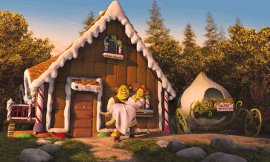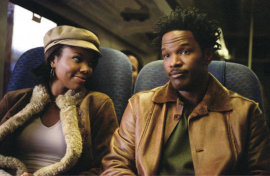 SHREK 2
SHREK 2
If a sequel manages to make any improvements on the original, it's usually cause for at least minor celebration, so I was pleased to see a few changes for the better in Dreamworks' computer-animated Shrek 2.
Now that the titular ogre is happily married and has calmed down a tad, Mike Myers isn't forced to bellow every line with that too-familiar Scottish growl he employs as Fat Bastard (and what feels like a thousand other Myers characterizations), the original film's continual onslaught on Disney characters and products has been confined, more or less, to the sequel's first 15 minutes, and, thankfully, we don't have to endure hearing Smash Mouth's "All Star" again (though I'm not sure the movie's onscreen performance of "La Vida Loca" isn't even worse). Best of all, Shrek 2 introduces us to what might be the series' most inspired creation: Antonio Banderas' sword-wielding Puss-in-Boots, who arrives with the brio of a feline conquistador yet has no qualms with breaking the action in order to lick himself. Together, Banderas and the film's animators make Puss the most riotous animated character we've seen since Ellen DeGeneres' Dory in Finding Nemo; when this tabby spends an eternity coughing up a hairball, or makes his wide-eyed Cute Kitty face (or, in a wickedly clever take-off on TV's Cops, when a bag of catnip falls out of Puss' pouch and he deadpans, "That's not mine"), Shrek 2 is everything you hope it'll be: witty, original, and very, very funny.
So what is it about the Shrek movies that, in the end, still bugs the hell out of me?
I'm thinking it has something to do with their blatant hypocrisy. The Shreks spend almost their entire running lengths goofing on the clichés that make Disney movies so typically tame and predictable, and then, after poking fun at said movies ad nauseum, they end up embracing all the storytelling clichés they were supposedly satirizing in the first place. Thankfully, this is never more egregious in Shrek 2 than it is during the opening romantic montage, but all throughout you get a whiff of superiority - a "we're cooler, we're hipper" vibe - that affects every character and every line of dialogue, and it gets to the point where you want to shout back at the screen, "Oh yeah? Prove it." The plot for Shrek 2 boils down to that old warhorse involving a girl's parents learning to love their son-in-law for who he is and not who they want him to be (it's Guess What Ogre's Coming to Dinner? ), and it's as predictably life-affirming and generically sweet as anything you'll find in Disney's output - Shrek 2 just adds gastrointestinal humor combined with a healthy dose of pop-culture references that promise to have a shelf life of about a year. For many, this will be comedy heaven, but for some of us it just comes across as cheap - an easy way to revel in everything the filmmakers supposedly deride.
Certainly, there is fun to be had in Shrek 2, especially among its peripheral characters; there's a great gag involving Pinocchio's attempts to not tell a lie, and, as in Shrek, the Gingerbread Man is good for a few chuckles (although surprisingly little comes the Stay-Puft Marshmallow Man-sized cookie at the finale). But, Puss-in-Boots excepted, the other new characters barely register - the film's nasty Fairy Godmother (voiced by Jennifer Saunders) has a musical number that would be fun if you could decipher any of her song's lyrics, and the characters voiced by John Cleese and Rupert Everett are distracting because they don't look anything like the actual Cleese or Everett; Shrek 2 reveals the built-in limitation to computer-animated characters that aren't toys or monsters: The line readings don't match up to the onscreen images. (The returning characters don't fare much better: As Shrek's bride, Cameron Diaz has even less to do here than she did in the original, and Eddie Murphy's Donkey has, to say the least, worn out his welcome.) Shrek 2 should easily satisfy the fan base that adored the original, but for the unconverted, this sequel - its moments of inspiration aside - will be just as irksome.
 BREAKIN' ALL THE RULES
BREAKIN' ALL THE RULES
Writer-director Daniel Taplitz's Breakin' All the Rules has such a promising farcical structure that it's a shame that more isn't done with it. Jamie Foxx plays Quincy, a magazine writer with a background in psychology, whose editor (Peter MacNicol) asks for assistance in downsizing their company; not wishing to be on the receiving end of a pissed-off employee with a shotgun, he demands that Quincy do the actual firing. At about the same time, Quincy gets dumped by his longtime girlfriend - at their engagement party, no less - and, in a desperate funk, he comes up with a brilliant idea: He writes a self-help manual teaching discontented lovers the proper way to end a relationship. (As Quincy's book sounds like a deliberate rebuke to Ellen Fein's and Sherrie Schneider's notorious bestseller The Rules, which helpfully instructed women in the art of landing a husband, the film's title is far more clever than its seemingly generic moniker would indicate.) Before long, the book becomes a national sensation, yet Quincy's newfound fame turns sour when everyone in his life - friends, co-workers, and his new love (Gabrielle Union) - begins employing Quincy's tactics against each other, and him.
Despite the sitcommy nature of the plot, Breakin' All the Rules features an elegant comedic notion - most of the characters think they're one step ahead of the others when they're really two steps behind - and a sensational cast; for most of its length, the movie is genial and enjoyable. Still, you keep wishing that the film were better than it is. Most of the key relationships make little sense, particularly the editor's romance with a voracious gold-digger (Jennifer Esposito), and the numerous subplots are wrapped up haphazardly, and in record time, to boot. (The fates of about six characters are explained in one hastily thrown-together sequence near the end; you could get whiplash trying to figure out who winds up with whom.) The movie doesn't work, yet Taplitz writes good, fast dialogue, especially in the scenes between Foxx and Morris Chestnut, playing Quincy's womanizing cousin. Their easygoing, familial banter gives the film some variety, and it was smart of Taplitz to buck against the traditional casting of these actors; Chestnut, who usually plays the upstanding leading man, gets to be the slovenly comic relief, and Foxx, an inventive wise-ass in supporting roles, displays romantic charisma and unexpected subtlety. Add to the mix Peter MacNicol's amusing smarminess as the token Unctuous White Guy, a strong vocal performance by Heather Headley, and the always-welcome presence of Gabrielle Union, and Breakin' All the Rules, while not quite successful, manages to be more purely likable than most of Hollywood's recent offerings.










